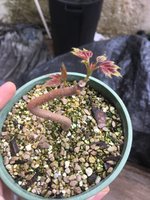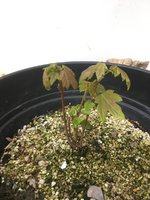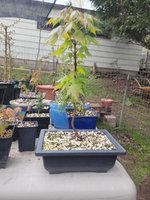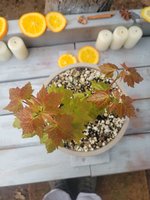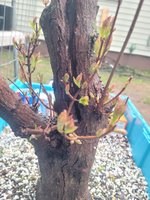By hiding out in your special "Tiny Trees" sub forum, away from the seasoned bonsai growers you guys are missing out on getting input from those who have "been there, and got the T-Shirt".
Look at threads started by Mach5 - Sergio, his Japanese maples are among the best by any USA artist. Sergio is a BNut regular and can be "summoned" for advice with the simple @ sign and Mach5. William Valavanis is also highly regarded for his maple work, he IS THE ONE who introduced 'Koto Hime' and a couple other Japanese maple cultivars to USA some 30 or 40 years ago. You need to look at and learn more about Japanese maples, as they really do define deciduous bonsai, Japanese bonsai grew up around the Japanese maple. There is much to learn in how JM are styled and techniques that could be applied to North American species. Pay more attention to JM techniques, you don't need to reinvent the wheel.
Acer platenoides - excellent for larger scale bonsai, often used by European bonsai growers, as it is one of their favorite native trees for bonsai. When you break a leaf petiole, the milky sap immediately distinguishes it from Acer saccharum, the North American Sugar maple. Otherwise the leaves are fairly similar. Walter Pall has a number of magnificent examples in his galleries. Look through Walter's blogs.
Acer saccharum - Sugar Maple - as bonsai is really only good for largest sizes, over 4 feet tall to get proportions correct. Leaves do not reduce easily. Hard to control internode length. Many have tried with this one, and generally had little success unless they went for largest size bonsai. Acer nigrum - rock maple or black maple, slightly better as bonsai, but still best for only largest trees.
Acer saccharinum - silver maple - a complete waste of time and effort. The silver maple lacks the one trait that "worthy maple species" have, silver maple has no autumn color. Leaves go from green to brown, with at best a brief glimpse of yellow for part of a day on the way to brown. The other maples will give you a week or more of reds, yellows, oranges, or other colors in a nice autumnal display. Silver maple is a drab tree, with no autumn pay off for all the work one puts into them.
Acer rubrum - proving to be good for medium to large size bonsai. Spring and autumn colors are good.
Acer x freemanii - (rubrum x saccharinum) - not as colorful as Acer rubrum, growth is more weedy, favoring the silver maple parent, but some of the spring and autumn color of the rubrum parent does come through. Wood is less brittle, so it is easier to wire than silver maple. While an improvement on silver maple, if one can get Acer rubrum they would be better investing time in that species
Acer negundo - box elder - weedy in growth habit, soft wood as for silver maple, a very nice example as bonsai was shown on BNUT nearly a decade ago, it was grown and developed in New Mexico. Again it was a larger specimen, which was necessary to get long internodes to be in proportion, something over 3 feet tall and wide. If anyone remembers the link please post here.


